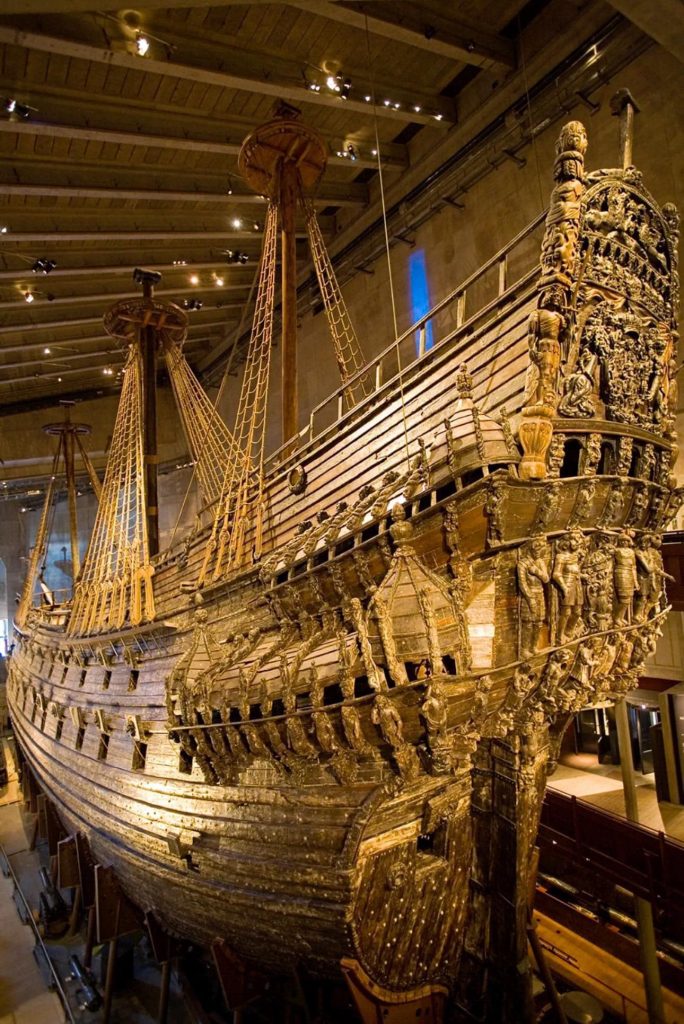In the heart of Stockholm between 1626 and 1628, Sweden embarked on an ambitious project to construct what was intended to be the crown jewel of its naval fleet—the warship Vasa. This grand vessel, adorned with intricate wooden carvings depicting the Swedish royal family and King Gustav II Adolf, was meticulously designed to showcase the empire’s naval dominance to the world. With its towering masts and rows of bronze cannons, Vasa symbolized Sweden’s aspirations to command the seas during a time of intense maritime competition. Every detail of the ship reflected both military prowess and artistic craftsmanship, making it not only a formidable war machine but also a floating testament to the wealth and power of the Swedish monarchy. Yet, beneath this magnificent exterior lay a critical design flaw that would seal its fate and turn a symbol of pride into a maritime tragedy.

Vasa was one of the most heavily armed vessels of its era, equipped with 64 cannons capable of delivering devastating firepower. The ship’s hull, constructed from sturdy oak, was built to withstand both enemy fire and the harsh conditions of the open sea. Its stern, decorated with gilded sculptures of lions, cherubs, and mythological figures, projected the image of Sweden as a force to be reckoned with. Despite its impressive design, the ship’s upper structure was dangerously overweight, creating an imbalance that compromised its stability. The decision to install a second gun deck, intended to enhance its firepower, added excessive weight above the waterline, making the ship top-heavy and prone to capsizing. Compounding this flaw was the lack of sufficient ballast—heavy stones placed in the hull to lower the center of gravity. Although tests were conducted to assess the ship’s stability, political pressure to meet construction deadlines led to these warnings being overlooked.
On August 10, 1628, Stockholm’s harbor buzzed with excitement as crowds gathered to witness Vasa’s maiden voyage. Cannons fired salutes as the ship set sail, its sails billowing in the summer breeze. For a brief moment, Vasa glided gracefully through the water, its hull cutting through the waves with elegance. However, the celebration quickly turned to horror as the ship encountered a stronger gust of wind. The upper structure, already unstable due to its excessive weight, caused the vessel to tilt precariously to one side. Although the ship managed to recover from the initial tilt, a second gust proved catastrophic. Water rushed through the open gun ports, flooding the lower decks and sealing the ship’s fate. Within minutes, Vasa sank to the seabed, just 1,300 meters from shore, as thousands of spectators watched in disbelief. The tragic loss of both the ship and many of its crew members cast a shadow over Sweden’s naval ambitions and led to widespread criticism of the project’s handling.
For more than three centuries, Vasa lay hidden beneath the cold, dark waters of the Baltic Sea. Unlike other maritime environments, the Baltic’s low salinity and oxygen-poor conditions created a natural preservative that slowed the decay of organic materials. This unique environment preserved approximately 95% of the ship’s wooden structure, shielding it from the wood-boring organisms that typically destroy sunken vessels. Over time, the ship became encased in layers of sediment, further protecting it from the elements. Despite its tragic fate, Vasa’s remarkable state of preservation would later transform it from a symbol of failure into one of the greatest archaeological discoveries of the 20th century.
In 1961, following years of meticulous planning and underwater exploration, marine archaeologists successfully raised Vasa from its watery grave. The recovery operation, led by Anders Franzén and a team of experts, captured the world’s attention as the nearly intact ship emerged from the depths. As the mud and silt were carefully removed, archaeologists discovered an astonishing array of artifacts that offered a rare glimpse into 17th-century life. Among the recovered items were finely crafted weapons, including muskets, pistols, and swords, as well as tools used by the ship’s crew and artisans. Personal belongings such as clothing, shoes, combs, and gaming pieces provided insight into the daily lives of both officers and sailors. The discovery of food containers, drinking vessels, and cooking utensils shed light on the crew’s diet and living conditions during long voyages. Remarkably, six of the ship’s original ten sails were found, preserved by the oxygen-deprived environment, offering valuable information about 17th-century sail-making techniques. Perhaps most poignant were the skeletal remains of at least 15 individuals, whose identities and stories remain the subject of ongoing research.
The discovery of Vasa and its artifacts revolutionized the field of maritime archaeology. Unlike traditional shipwrecks, which often yield only fragments of their original structure, Vasa’s near-complete preservation allowed researchers to study the ship’s construction techniques and design flaws in unprecedented detail. The vessel’s intricate carvings provided insight into the artistic and cultural influences of the time, reflecting both classical mythology and Swedish national identity. The artifacts recovered from the ship offered a tangible connection to the lives of the people who built, sailed, and perished aboard Vasa, bridging the gap between past and present.
Today, Vasa stands proudly in the Vasa Museum in Stockholm, where it continues to captivate visitors from around the world. Housed within a specially designed climate-controlled environment, the ship remains a testament to both human ingenuity and the consequences of ambition unchecked by practicality. The museum’s exhibits, which include meticulously restored artifacts and interactive displays, allow visitors to explore every aspect of the ship’s construction, voyage, and rediscovery. Through ongoing research and conservation efforts, archaeologists continue to unlock new insights into 17th-century shipbuilding, naval warfare, and daily life. The legacy of Vasa serves as a powerful reminder that even the most ambitious endeavors can falter, yet their lessons and legacies endure, offering future generations the opportunity to learn from both triumph and tragedy.





